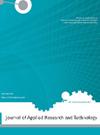Influence of sequential pyrolisis methods on the properties of the carbon nanostructure (CNS) from sugarcane leaf biomass
Q3 Engineering
Journal of Applied Research and Technology
Pub Date : 2022-08-31
DOI:10.22201/icat.24486736e.2022.20.4.1324
引用次数: 0
Abstract
Plant biomass is a potential lignocellulose material for synthesis of carbon nano structure. Its characteristics as adsorbent and its size particle make it good additive for liquid fertilizer. In this research, we study influence of sequential different pressure pyrolysis methods (hydrothermal–microwave method and reflux–microwave method) toward characteristics of carbon nanostructure from sugarcane leaf biomass. Each reflux and hydrothermal method was adjusted at 200oC, then followed by microwave at 800W. Characterization showed that the hydrothermal - microwave method using X-ray diffraction indicates diffractogram patterns of both carbon nanostructure and cellulose. SEM micrographs show sphere and block shapes. FTIR spectra indicates different concentration of oxy surface functional groups. UV spectra of the dispersed product in water indicates existence of aromatics C=C groups. The hydrothermal - microwave method resulted the product inwhich lower crystalinity index of cellulose, smaller particles, lower concentration of oxy surface groups than the reflux - microwave one. Correlation of chemical properties (aromaticity and fraction of polar groups) was more linier than of physical - chemical properties (indexe of cellulose crystalinity and fraction of polar groups). The stability of colloid was indicated by dispersing technique in order of sonication < blending < blending - sonication.顺序热解方法对甘蔗叶片生物质碳纳米结构性质的影响
植物生物量是合成碳纳米结构的潜在木质纤维素材料。它的吸附剂特性和颗粒大小使其成为液体肥料的良好添加剂。在本研究中,我们研究了顺序不同压力热解方法(水热-微波法和回流-微波法)对甘蔗叶片生物质碳纳米结构特性的影响。每次回流和水热法在200oC下调节,然后在800W下微波。表征结果表明,水热微波法x射线衍射显示了碳纳米结构和纤维素的衍射图。扫描电镜显微图显示球形和块状。FTIR光谱显示不同浓度的氧表面官能团。分散产物在水中的紫外光谱表明存在芳烃C=C基团。与回流微波法相比,水热微波法制备的产物纤维素的结晶度指数更低,颗粒更小,表面氧基浓度更低。化学性质(芳香性和极性基团分数)的相关性比理化性质(纤维素结晶度指数和极性基团分数)的相关性更小。用分散法对胶体的稳定性进行了表征,其顺序为超声<共混<共混-超声。
本文章由计算机程序翻译,如有差异,请以英文原文为准。
求助全文
约1分钟内获得全文
求助全文
来源期刊

Journal of Applied Research and Technology
工程技术-工程:电子与电气
CiteScore
1.50
自引率
0.00%
发文量
0
审稿时长
6-12 weeks
期刊介绍:
The Journal of Applied Research and Technology (JART) is a bimonthly open access journal that publishes papers on innovative applications, development of new technologies and efficient solutions in engineering, computing and scientific research. JART publishes manuscripts describing original research, with significant results based on experimental, theoretical and numerical work.
The journal does not charge for submission, processing, publication of manuscripts or for color reproduction of photographs.
JART classifies research into the following main fields:
-Material Science:
Biomaterials, carbon, ceramics, composite, metals, polymers, thin films, functional materials and semiconductors.
-Computer Science:
Computer graphics and visualization, programming, human-computer interaction, neural networks, image processing and software engineering.
-Industrial Engineering:
Operations research, systems engineering, management science, complex systems and cybernetics applications and information technologies
-Electronic Engineering:
Solid-state physics, radio engineering, telecommunications, control systems, signal processing, power electronics, electronic devices and circuits and automation.
-Instrumentation engineering and science:
Measurement devices (pressure, temperature, flow, voltage, frequency etc.), precision engineering, medical devices, instrumentation for education (devices and software), sensor technology, mechatronics and robotics.
 求助内容:
求助内容: 应助结果提醒方式:
应助结果提醒方式:


